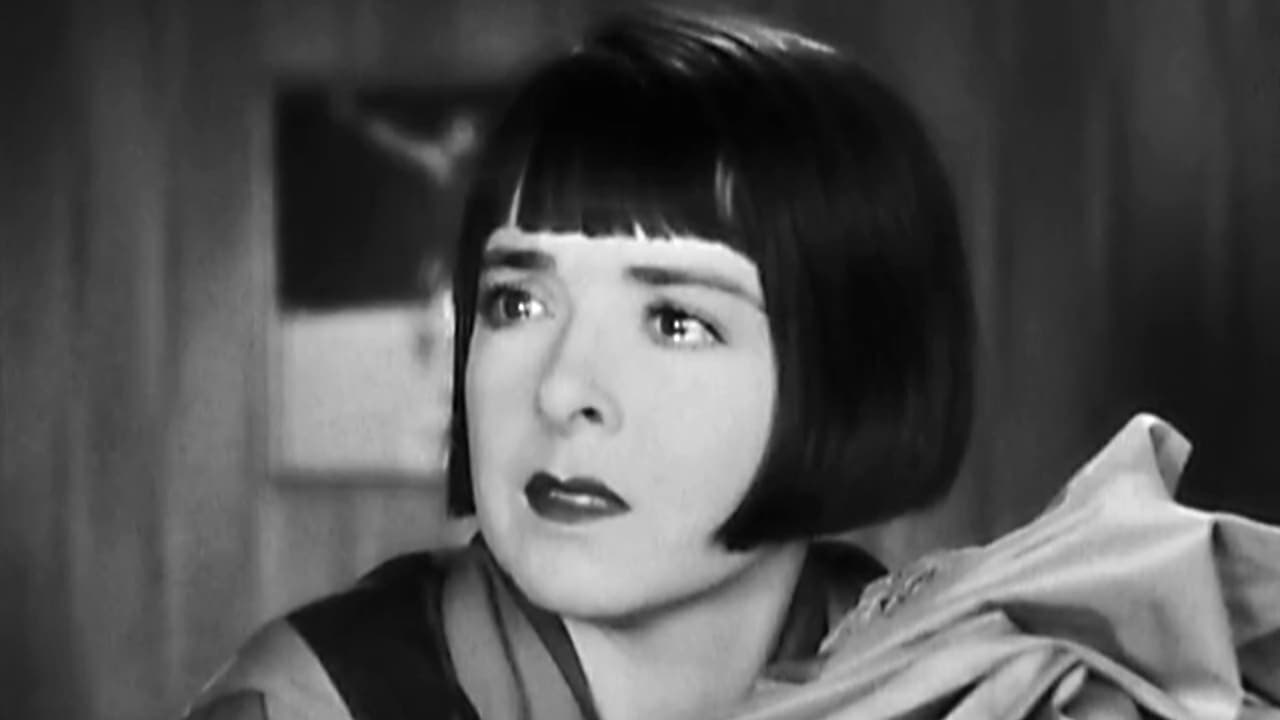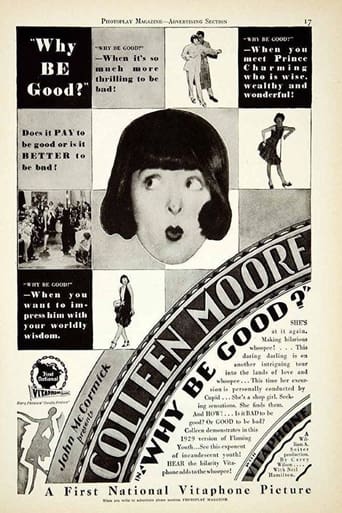


To me, this movie is perfection.
... View MoreAn Exercise In Nonsense
... View MoreThe movie's neither hopeful in contrived ways, nor hopeless in different contrived ways. Somehow it manages to be wonderful
... View MoreClose shines in drama with strong language, adult themes.
... View MoreDreadful picture. One of the worst pictures I have seen from 1929. The main characters awaken absolutely no sympathy from the viewer. Watching the 30 year old Colleen Moore trying to act like a dumb teenager is absolutely ridiculous. Furthermore, the thought of someone like Neil Hamilton (or any sane person for that matter) falling in love with such a silly ridiculous person (dressed in some of the most ridiculous fashions I have seen) is beyond belief. Almost every other women in the picture, including the extras, are much more attractive that she is. I am also shocked on how bad the Synchronized Score is, especially as this is a First National picture, as all other example of Synchronized musical scoring I have heard from 1928-1929 for First National pictures are quite elegant and tasteful. The music in the dancing sequences is crass and annoying and I find it hard to believe that the extras were dancing to anything even remotely sounding like that.If you look at film trade reviews from the period, the film did very poorly upon release. I'm surprised that First National produced two expensive all talking musicals ("Smiling Irish Eyes" and "Footlights and Fools" with Technicolor sequences) in 1929 after this disaster.. again starring Colleen Moore... which are lost but frankly after seeing this film it is no great loss if her acting in those pictures was even remotely similar to that she gives in the disaster known as "Why Be Good"
... View MoreNo movie better illustrates the inherent contradiction of the Hollywood flapper than Why Be Good? (1929). Colleen Moore is a party girl who wears make-up, bobbed hair, and short skirts. She flirts with young men and has built quite the reputation for herself; however, she (and the film) makes it clear that she is a "good girl" despite everything. Sexual liberation hand in hand with conservative values so that the audience isn't too radicalized.This quality was my biggest issue with that second most famous of flapper pictures Our Dancing Daughters (1928) with Joan Crawford as the virginal flapper who is held up as an ideal modern girl in comparison with the Anita Page character, who sleeps around and is thus a horrible person who must be punished. Though that film claims to be modern, it upholds Victorian morality with relish. Yet in Why Be Good? the double standard is firmly attacked. While we are assured that Moore is a virgin with some conservative sexual values, the movie stands up against the double standard. When the male love interest is swayed by his sexist father into thinking Moore is trash because she flirts and parties, Moore shoots him down, claiming that if she stayed home and "darned socks" she would have hardly attracted his attention in the first place. In a society where a good girl is labeled a "prude" and a party girl a "tramp," a woman just can't win.Well not here. In the end, the flapper wins the boy and the day. The message is quite progressive for the time, far ahead of Our Dancing Daughters. It's also more fun, with Moore showing off her charm and comic talent to great effect. She also sports some great playful sex appeal here. The Vitaphone score paired with the film is excellent, giving you a great sense of the time period, all jazz and Charlestons.I've rambled on enough, so let me make it brief: watch this movie. Colleen Moore is funny and the message quite modern, one society still has not fully taken to heart, even in the 21st century.
... View MoreOn the 50th floor of a modern skyscraper in New York City, handsome young millionaire Neil Hamilton (as Winthrop Peabody Jr.) has a wild party to celebrate a new job managing his father's department store. In a poorer section of town, perky flapper Colleen Moore (as Pert Kelly) dances at fast-motion to "Sweet Georgia Brown" in a Charleston contest. A clear winner, Ms. Moore is also one of the thousand "cuties" employed as a clerk at Peabody's department store. Later, she hooks up with Mr. Hamilton at a hot roadhouse called "The Boiler". Moore angers her parents by arriving home late, but she really lives a virtuous life. However, Moore is late for work and ordered to see the new store manager...Moore's last silent is very nicely produced, for its star, by John McCormick. Director William A. Seiter and his crew present Moore in a flattering light, and give us a tasteful peak at her underwear in a couple of scenes. Trying to make time with Moore before she meets Hamilton, amorously greasy Louis Natheaux (as Jimmy Alexander) is a stand-out. Carey Wilson's story was a standard for the time. A pretty clerk getting attention from an (ideally, department store) millionaire was a common fantasy. The plot was well-worn, and doesn't fit the "flapper" girl. Mary Pickford and Clara Bow had released finer films on the topic. Moore's best rags-to-riches story is, appropriately, "Ella Cinders" (1926)...This was Moore's final "silent" film. She transitioned to the "talkies" as well-spoken, but without distinction. Moore was likely hurt by being so closely associated with a bygone era. She was #1 in the industry's "Quigley Poll" of box-office stars for 1926. "Why Be Good" finds its star acting almost purely with the exaggerated silent mannerisms associated with silents. In the past, Moore demonstrated some of the subtly and style which would prove useful in all-talking pictures; but, here, she makes her preference known. The recently re-discovered print of "Why Be Good?" is spectacular, and it survives with its beautifully rendered "Synchronized Musical Score and Sound Effects" track. Let's see more...****** Why Be Good? (1929-02-28) William A. Seiter ~ Colleen Moore, Neil Hamilton, Louis Natheaux, Bodil Rosing
... View MoreColleen Moore stars as Pert Kelly, a sales girl in a department store by day and a jazz baby by night. One night she meets a guy (Neil Hamilton) who happens to be the son of the department store owner. They hit it off, but when she's late for work the following morning, she's called into his office and they discover who they are. She's fired by the store owner, but she thinks the son did it. Rich daddy tries to protect his son from that kind of girl and talks him into testing her by taking her to a hotel to see how she reacts. Is she a good girl? Does it matter? After all, why be good? Moore is terrific as the dance-crazed flapper (who still lives at home with mom and pop). With her signature hair-do and skimpy dresses, she the very picture of the silent flapper. Hamilton is also good as the naïve son. Co-stars include Jack Norton as the drunken boyfriend, Bodil Rosing as the mother, John St. Polis as the father, and Edward Martindel as the store owner. Look fast for Grady Sutton, Mischa Auer, and Jean Harlow among the revelers.This film was recently released on DVD after a massive effort to restore its video elements from several sources and its excellent Vitaphone soundtrack. After being listed as a lost film for many decades, we now have a shiny new version restored and available.
... View More